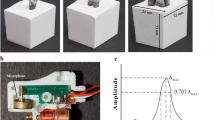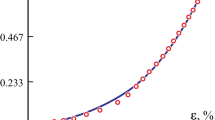Abstract
The purpose of this study was to evaluate the possibility of using natural frequency (NF) analysis to detect the attachment loss of periodontal tissue. In this study, 698 anterior teeth were examined by a conventional probing method and also by NF analysis. The teeth were triggered to vibrate with an impulse hammer, and the vibrational response was detected by an acoustic sensor. Our results demonstrate no significant difference in NF values between the upper–lower/left–right quadrants of the tested teeth, although the mean natural frequency value of central incisors with periodontal disease was found to be 1.24 ± 0.11 kHz which is significantly lower than that of teeth in a healthy condition (1.34 ± 0.20 kHz; p < 0.01). On the other hand, the mean frequency for periodontal disease involving canines (1.28 ± 0.09 kHz) was also significantly lower than the corresponding value for healthy analogs (1.35 ± 0.17 kHz; p < 0.05). These results suggest that NF analysis appears to be an effective method for assessing the periodontal condition of anterior teeth. Moreover, since this method is noninvasive, nondestructive, and necessitates minimal tooth contact, it can serve as an effective method for the early quantifiable testing and prevention of periodontal disease. © 2001 Biomedical Engineering Society.
PAC01: 8780-y, 4380Ev, 8719Rr
Similar content being viewed by others
REFERENCES
Armitage, G. C., R. J. Genco, H. M. Goldman, and D. W. Cohen. Clinical Periodontal Examination. St. Louis: CV Mosby, 1990, pp. 341–344.
Armitage, G. C., G. K. Svanberg., and H. LÖe. Microscopic evaluation of clinical measurements of connective tissue attachment level. J. Clin. Periodontol.4.:173–190., 1977.
Christensen, A. B., F. Ammitzboll., C. Dyrbye., M. Cornelissen., P. Cornelissen., and G. Van der Perre. Assessment of tibia stiffness by vibration testing in situ. I. Identification of mode shapes in different supporting conditions. J. Biomech.19.:53–60., 1986.
Cornelissen, P., M. Cornelissen., and G. Van der Perre. Assessment of tibial stiffness by vibration testing in situ. II. Influence of soft tissues, joints, and fibula. J. Biomech.19.:551–561., 1986.
Friberg, B., L. Sennerby., B. Linden., K. GrÖndahl., and U. Lekhilm. Stability measurements of one-stage BrÅnemark implants during healing in mandibles. Int. J. Oral Maxillofac. Surg.28.:266–272., 1999.
Hobatho, M. C., R. Damana., P. Pastor., J. J. Barrau., S. Laroze., and J. P. Morucci. Development of a three-dimensional finite-element model of a human tibia using experimental model analysis. J. Biomech.24.:371–383., 1991.
Huang, H. M., L. C. Pan., S. Y. Lee., C. L. Chiu., K. H. Fan., and K. N. Ho. Assessing the implant/bone interface by using natural frequency analysis: An in vitro. study. Oral Surg., Oral Med., Oral Path.90.:285–291., 2000.
Listgarten, M. A. Periodontal probing: What does it mean?.J. Clin. Periodontol.7.:65–176., 1980.
Lee, S. Y., H. M. Huang., and C. Y. Lin. In vivo. and in vitro. natural frequency analysis of periodontal conditions, an innovative method. J. Periodontal.74.:632–640., 2000.
Lekholm, U., and G. A. Zarb. Patient selection and preparation. In: Tissue-Integrated Prostheses: Osseointegration in Clinical Density, edited by P. I. BrÅnemark, G. A. Zarb, and T. Albrektsson. Chicago: Quintessence, 1985, pp. 199–209.
Lowet, G., X. Dayuan., and G. Van der Perre. Study of the vibrational behavior of a healing tibia using-finite element modeling. J. Biomech.29.:1003–1010., 1996.
Lowet, G., R. Van Audekercke., G. Van der Perre., P. Geusens., J. Dequeker., and J. Lammens. The relation between resonant frequencies and torsional stiffness of long bones: In vitro. validation of a simple beam model. J. Biomech.26.:689–696., 1993.
Meredith, N., D. Alleyne., and P. Cawley. Quantitative determination of the stability of the implant-tissue interface using resonance frequency analysis. Clin. Oral Impl. Res.7.:261–267., 1996.
Meredith, N., K. Book., B. Friberg., T. Jemt., and L. Sennerby. Resonance frequency measurements of implant stability in vivo.. Clin. Oral. Impl. Res.8.:226–233., 1997.
Noyes, D. H., and C. W. Solt. Measurement of mechanical mobility of human incisors with sinusoidal forces. J. Biomech.6.:439–442., 1973.
Okazaki, M., M. Fukumoto., and J. Takahashi. Damped oscillation analysis of natural and artificial periodontal membrane. Ann. Biomed. Eng.24.:234–240., 1996.
Polson, A. M., J. G. Caton., R. N. Yeaple., and H. A. Zander. Histological determination of probe tip penetration into gingival sulcus of humans using an electronic pressure-sensitive probe. J. Clin. Periodontol.7.:479–488., 1980.
Ramfjord, S. P..Indices for prevalence and incidence of periodontal disease. J. Periodontal.30.:51–59., 1959.
Rasmusson, L., N. Meredith., I. H. Cho., and L. Sennerby. The influence of simultaneous versus delayed placement on the stability of titanium implants in onlay bone grafts. Int. J. Oral Maxillofac. Surg.28.:224–231., 1999.
Robinson, P. J., and R. M. Vitek. The relationship between gingival inflammation and resistance to probe penetration. J. Periodontal. Res.14.:239–243., 1979.
Saglie, R., J. R. Johansen., and L. Flotra. The zone of completely and partially destructed periodontal fibers in pathological pockets. J. Clin. Periodontol.2.:198–202., 1975.
Sennerby, L., and N. Meredith. Resonance frequency analysis: Measuring implant stability and osseointegration. Compendium.19.:493–502., 1998.
Shillingburg, Jr., H. T., S. Hobo, L. D. Whitsett, R. Jacobi, and S. E. Brackett. Fundamental of Fixed Prosthodontics. Chicago: Quintessence, 1997, pp. 85–103.
Thomson, W. T. Theory of Vibration with Applications. Englewood Cliffs, NJ: Prentice-Hall, 1988, pp. 221–224.
Van der Perre, G., R. Van Audekerke., M. Martens., and J. C. Mulier. Identification of in vivo. vibration modes of human tibiae by modal analysis. J. Biomed. Eng.105.:244–248., 1983.
Wong, F. Y., S. Pal., and S. Saha. The assessment of in vivo. bone condition in humans by impact response measure. J. Biomech.16.:849–856., 1983.
Author information
Authors and Affiliations
Rights and permissions
About this article
Cite this article
Huang, HM., Lee, SY., Yeh, CY. et al. Natural Frequency Analysis of Periodontal Conditions in Human Anterior Teeth. Annals of Biomedical Engineering 29, 915–920 (2001). https://doi.org/10.1114/1.1408925
Issue Date:
DOI: https://doi.org/10.1114/1.1408925




